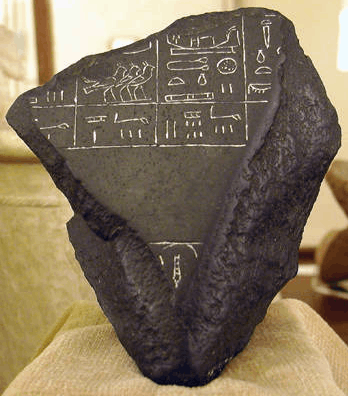Papyrus roll-tied (hieroglyph)
| |||||||
| Papyrus Roll- -Tied m(dj)3t in hieroglyphs |
|---|
Painted Thutmosis III cartouches (temple relief), Deir el-Bahari.
(reads left-to-right)
(reads left-to-right)
The ancient Egyptian Papyrus roll-tied & sealed (hieroglyph) comes in the common horizontal, or a vertical form (shown in photo). It is juxtaposed against an open scroll, the Papyrus roll-open (hieroglyph),
, without the "visible ties". The sealed form can also have a seal impressed (in clay) on the tie, for security, or authentication, (see notarization). Both styles of the papyrus roll, "-tied" or "-open", are an ideogram for "roll of papyrus", with a phonetic value of m(dj)3t.[1]
|
Some artistic versions of the papyrus roll show the laminations, or grid-work, the cross-hatching of the papyrus fibers, for example on Thutmosis III's cartouches (in photo, end of line 1 (reads left-to-right)).

Finely painted Egyptian hieroglyph sample.
Finely detailed limestone relief example of tied papyrus hieroglyph.
|
|
See also
| Wikimedia Commons has media related to Papyrus roll-tied (hieroglyph). |
References
- ↑ Betrò, 1995. Hieroglyphics: The Writings of Ancient Egypt, p. 237.
- Betrò, 1995. Hieroglyphics: The Writings of Ancient Egypt, Betrò, Maria Carmela, c. 1995, 1996-(English), Abbeville Press Publishers, New York, London, Paris (hardcover, ISBN 0-7892-0232-8)
- Budge, (1920), 1978. An Egyptian Hieroglyphic Dictionary, E.A.Wallace Budge, (Dover Publications), c 1978, (c 1920), Dover edition, 1978. (In two volumes, 1314 pp. and cliv-(154) pp.) (softcover, ISBN 0-486-23615-3)
This article is issued from Wikipedia - version of the 11/21/2016. The text is available under the Creative Commons Attribution/Share Alike but additional terms may apply for the media files.

